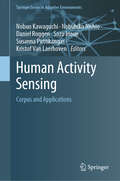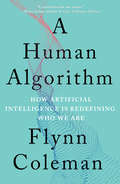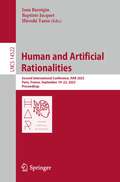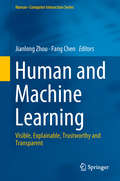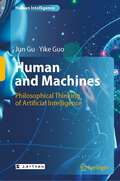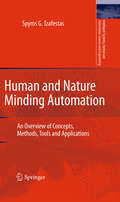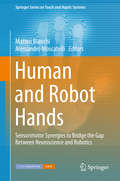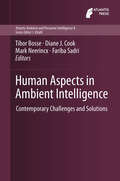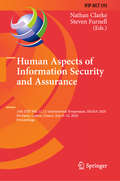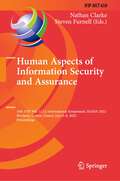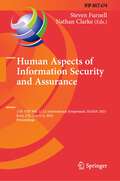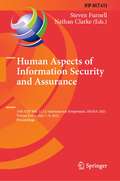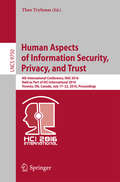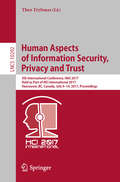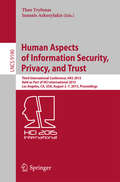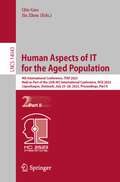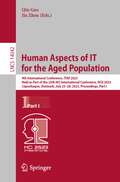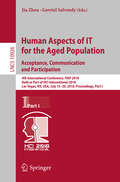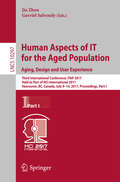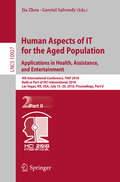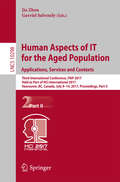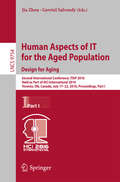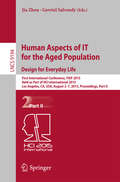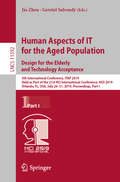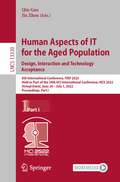- Table View
- List View
Human Activity Sensing: Corpus and Applications (Springer Series in Adaptive Environments)
by Nobuo Kawaguchi Nobuhiko Nishio Daniel Roggen Sozo Inoue Susanna Pirttikangas Kristof Van LaerhovenActivity recognition has emerged as a challenging and high-impact research field, as over the past years smaller and more powerful sensors have been introduced in wide-spread consumer devices. Validation of techniques and algorithms requires large-scale human activity corpuses and improved methods to recognize activities and the contexts in which they occur. This book deals with the challenges of designing valid and reproducible experiments, running large-scale dataset collection campaigns, designing activity and context recognition methods that are robust and adaptive, and evaluating activity recognition systems in the real world with real users.
A Human Algorithm: How Artificial Intelligence Is Redefining Who We Are
by Flynn ColemanA groundbreaking narrative on the urgency of ethically designed AI and a guidebook to reimagining life in the era of intelligent technology.The Age of Intelligent Machines is upon us, and we are at a reflection point. The proliferation of fast–moving technologies, including forms of artificial intelligence akin to a new species, will cause us to confront profound questions about ourselves. The era of human intellectual superiority is ending, and we need to plan for this monumental shift.A Human Algorithm: How Artificial Intelligence Is Redefining Who We Are examines the immense impact intelligent technology will have on humanity. These machines, while challenging our personal beliefs and our socioeconomic world order, also have the potential to transform our health and well–being, alleviate poverty and suffering, and reveal the mysteries of intelligence and consciousness. International human rights attorney Flynn Coleman deftly argues that it is critical that we instill values, ethics, and morals into our robots, algorithms, and other forms of AI. Equally important, we need to develop and implement laws, policies, and oversight mechanisms to protect us from tech’s insidious threats.To realize AI’s transcendent potential, Coleman advocates for inviting a diverse group of voices to participate in designing our intelligent machines and using our moral imagination to ensure that human rights, empathy, and equity are core principles of emerging technologies. Ultimately, A Human Algorithm is a clarion call for building a more humane future and moving conscientiously into a new frontier of our own design.“[Coleman] argues that the algorithms of machine learning––if they are instilled with human ethics and values––could bring about a new era of enlightenment.” —San Francisco Chronicle
Human and Artificial Rationalities: Second International Conference, HAR 2023, Paris, France, September 19–22, 2023, Proceedings (Lecture Notes in Computer Science #14522)
by Jean Baratgin Baptiste Jacquet Hiroshi YamaThis book constitutes the proceedings of the Second International Conference on Human and Artificial Rationalities, HAR 2023, which took place in Paris, France, in September 2023. The 18 full and 5 short papers included in this book were carefully reviewed and selected from 39 submissions. They were organized in topical sections as follows: Human and artificial thinking; human thinking and reasoning; neuropsychology and interaction; artificial agents and interaction; and applied reasoning. This volume also contains 2 invited talks in full-paper length.
Human and Machine Learning: Visible, Explainable, Trustworthy and Transparent (Human–Computer Interaction Series)
by Jianlong Zhou Fang ChenWith an evolutionary advancement of Machine Learning (ML) algorithms, a rapid increase of data volumes and a significant improvement of computation powers, machine learning becomes hot in different applications. However, because of the nature of “black-box” in ML methods, ML still needs to be interpreted to link human and machine learning for transparency and user acceptance of delivered solutions. This edited book addresses such links from the perspectives of visualisation, explanation, trustworthiness and transparency. The book establishes the link between human and machine learning by exploring transparency in machine learning, visual explanation of ML processes, algorithmic explanation of ML models, human cognitive responses in ML-based decision making, human evaluation of machine learning and domain knowledge in transparent ML applications. This is the first book of its kind to systematically understand the current active research activities and outcomes related to human and machine learning. The book will not only inspire researchers to passionately develop new algorithms incorporating human for human-centred ML algorithms, resulting in the overall advancement of ML, but also help ML practitioners proactively use ML outputs for informative and trustworthy decision making. This book is intended for researchers and practitioners involved with machine learning and its applications. The book will especially benefit researchers in areas like artificial intelligence, decision support systems and human-computer interaction.
Human and Machines: Philosophical Thinking of Artificial Intelligence (Human Intelligence)
by Jun Gu Yike GuoThis book shares Chinese scholars’ philosophical views on artificial intelligence. The discussions range from the foundations of AI—the Turing test and creation of machine intelligence—to recent applications of AI, including decisions in games, natural languages, pattern recognition, prediction in economic contexts, autonomous behaviors, and collaborative intelligence, with the examples of AlphaGo, Microsoft’s Xiao Bing, medical robots, etc. The book’s closing chapter focuses on Chinese machines and explores questions on the cultural background of artificial intelligence. Given its scope, the book offers a valuable resource for all members of the general public who are interested in the future development of artificial intelligence, especially from the perspective of respected Chinese scholars.
Human and Nature Minding Automation
by Spyros G. TzafestasThis book examines the "symbiosis" of automation and technology with the human and the nature towards the ultimate goal of assuring global sustainability. Throughout the years a variety of approaches, technologies and practices have been produced in the direction of achieving human-and nature-minding automation and industrial activity. In this book an attempt is made, for the first time, to present in a cohesive and consolidated way an overview of all these issues together, and show how they combine to provide human-and nature-minding (green) systems. Human-minding automation is possible by employing concepts and techniques from the human factors and ergonomics fields, including job satisfaction, human-friendly interfaces, and human values, whereas nature-minding industrial activity and human development can be achieved by considering as a whole the human, economic, natural and cultural resources in the short and long term. In particular, nature-minding design selects the production methods and technologies that have the minimum impact to the nature. The book is intended for use both as a free reference conceptual book, and as general introductory book in relevant teaching and research environments.
Human and Robot Hands
by Matteo Bianchi Alessandro MoscatelliThis booklooks at the common problems both human and robotic hands encounter when controllingthe large number of joints, actuators and sensors required to efficientlyperform motor tasks such as object exploration, manipulation and grasping. The authorsadopt an integrated approach to explore the control of the hand based onsensorimotor synergies that can be applied in both neuroscience androbotics. Hand synergies are based on goal-directed, combined muscle andkinematic activation leading to a reduction of the dimensionality of the motorand sensory space, presenting a highly effective solution for the fast and simplifieddesign of artificial systems. Presented intwo parts, the first part, Neuroscience, provides the theoretical andexperimental foundations to describe the synergistic organization of the humanhand. The second part, Robotics, Models and Sensing Tools, exploits theframework of hand synergies to better control and design robotic hands andhaptic/sensing systems/tools, using a reduced number of control inputs/sensors,with the goal of pushing their effectiveness close to the natural one. Human andRobot Hands provides a valuable reference for students, researchers anddesigners who are interested in the study and design of the artificial hand.
Human Aspects in Ambient Intelligence
by Tibor Bosse Diane J. Cook Mark Neerincx Fariba SadriThis book presents recent developments is the field of human aspects in Ambient Intelligence. This field, and the associated workshop series, addresses multidisciplinary aspects of AmI with human-directed disciplines such as psychology, social science, neuroscience and biomedical sciences. The aim of the workshop series is to get researchers together from these human-directed disciplines or working on cross connections of AmI with these disciplines. The focus is on the use of knowledge from these disciplines in AmI applications, in order to support humans in their daily living in medical, psychological and social respects. The book plays important role to get modellers in the psychological, neurological, social or biomedical disciplines interested in AmI as a high-potential application area for their models. From the other side, the book may make researchers in Computer Science and Artificial and Ambient Intelligence more aware of the possibilities to incorporate more substantial knowledge from the psychological, neurological, social and biomedical disciplines in AmI architectures and applications.
Human Aspects of Information Security and Assurance: 14th IFIP WG 11.12 International Symposium, HAISA 2020, Mytilene, Lesbos, Greece, July 8–10, 2020, Proceedings (IFIP Advances in Information and Communication Technology #593)
by Nathan Clarke Steven FurnellThis book constitutes the proceedings of the 14th International Symposium on Human Aspects of Information Security and Assurance, HAISA 2020, held in Mytilene, Lesbos, Greece, in July 2020.* The 27 full papers presented in this volume were carefully reviewed and selected from 43 submissions. They are organized in the following topical sections: privacy and COVID-19; awareness and training; social engineering; security behavior; education; end-user security; usable security; security policy; and attitudes and perceptions. *The symposium was held virtually due to the COVID-19 pandemic.
Human Aspects of Information Security and Assurance: 16th IFIP WG 11.12 International Symposium, HAISA 2022, Mytilene, Lesbos, Greece, July 6–8, 2022, Proceedings (IFIP Advances in Information and Communication Technology #658)
by Nathan Clarke Steven FurnellThis book constitutes the proceedings of the 16th IFIP WG 11.12 International Symposium on Human Aspects of Information Security and Assurance, HAISA 2022, held in Mytilene, Lesbos, Greece, in July 2022. The 25 papers presented in this volume were carefully reviewed and selected from 30 submissions. They are organized in the following topical sections: cyber security education and training; cyber security culture; privacy; and cyber security management.
Human Aspects of Information Security and Assurance: 17th IFIP WG 11.12 International Symposium, HAISA 2023, Kent, UK, July 4–6, 2023, Proceedings (IFIP Advances in Information and Communication Technology #674)
by Steven Furnell Nathan ClarkeThis book constitutes the proceedings of the 17th IFIP WG 11.12 International Symposium on Human Aspects of Information Security and Assurance, HAISA 2023, held in Kent, United Kingdom, in July 2023. The 37 full papers presented in this volume were carefully reviewed and selected from 54 submissions. They are organized in the following topical sections: education and training; management, policy and skills; evolving threats and attacks; social-technical factors; and research methods.
Human Aspects of Information Security and Assurance: 15th IFIP WG 11.12 International Symposium, HAISA 2021, Virtual Event, July 7–9, 2021, Proceedings (IFIP Advances in Information and Communication Technology #613)
by Steven Furnell Nathan ClarkeThis book constitutes the proceedings of the 15th IFIP WG 11.12 International Symposium on Human Aspects of Information Security and Assurance, HAISA 2021, held virtually in July 2021.The 18 papers presented in this volume were carefully reviewed and selected from 30 submissions. They are organized in the following topical sections: attitudes and perspectives; cyber security education; and people and technology.
Human Aspects of Information Security, Privacy, and Trust
by Theo TryfonasThis book constitutes the proceedings of the Third International Conference on Human Aspects of Information Security, Privacy, and Trust, HAS 2015, held as part of the 17th International Conference on Human-Computer Interaction, HCII 2015, held in Los Angeles, CA, USA, in August 2015 and received a total of 4843 submissions, of which 1462 papers and 246 posters were accepted for publication after a careful reviewing process. These papers address the latest research and development efforts and highlight the human aspects of design and use of computing systems. The papers thoroughly cover the entire field of Human-Computer Interaction, addressing major advances in knowledge and effective use of computers in a variety of application areas. The 62 papers presented in the HAS 2015 proceedings are organized in topical sections as follows: authentication, cybersecurity, privacy, security, and user behavior, security in social media and smart technologies, and security technologies.
Human Aspects of Information Security, Privacy and Trust: 5th International Conference, HAS 2017, Held as Part of HCI International 2017, Vancouver, BC, Canada, July 9-14, 2017, Proceedings (Lecture Notes in Computer Science #10292)
by Theo TryfonasThis book constitutes the proceedings of the Second International Conference on Human Aspects of Information Security, Privacy, and Trust, HAS 2014, held as part of HCI International 2014 which took place in Heraklion, Crete, Greece, in June 2014 and incorporated 14 conferences which similar thematic areas. HCII 2014 received a total of 4766 submissions, of which 1476 papers and 220 posters were accepted for publication after a careful reviewing process. These papers address the latest research and development efforts and highlight the human aspects of design and use of computing systems. The papers thoroughly cover the entire field of Human-Computer Interaction, addressing major advances in knowledge and effective use of computers in a variety of application areas. The 38 papers presented in the HAS 2014 proceedings are organized in topical sections named: usable security; authentication and passwords; security policy and awareness; human behaviour in cyber security and privacy issues.
Human Aspects of Information Security, Privacy, and Trust
by Theo Tryfonas Ioannis AskoxylakisThis book constitutes the proceedings of the Third International Conference on Human Aspects of Information Security, Privacy, and Trust, HAS 2015, held as part of the 17th International Conference on Human-Computer Interaction, HCII 2015, held in Los Angeles, CA, USA, in August 2015 and received a total of 4843 submissions, of which 1462 papers and 246 posters were accepted for publication after a careful reviewing process. These papers address the latest research and development efforts and highlight the human aspects of design and use of computing systems. The papers thoroughly cover the entire field of Human-Computer Interaction, addressing major advances in knowledge and effective use of computers in a variety of application areas. The 62 papers presented in the HAS 2015 proceedings are organized in topical sections as follows: authentication, cybersecurity, privacy, security, and user behavior, security in social media and smart technologies, and security technologies.
Human Aspects of IT for the Aged Population: 9th International Conference, ITAP 2023, Held as Part of the 25th HCI International Conference, HCII 2023, Copenhagen, Denmark, July 23–28, 2023, Proceedings, Part II (Lecture Notes in Computer Science #14043)
by Qin Gao Jia ZhouThis two-volume set of ITAP 2023, constitutes the refereed proceedings of the 9th International Conference on Human Aspects of IT for the Aged Population, ITAP 2023, held as Part of the 24th International Conference, HCI International 2023, which took place in July 2023 in Copenhagen, Denmark. The total of 1578 papers and 396 posters included in the HCII 2023 proceedings volumes was carefully reviewed and selected from 7472 submissions. The papers of ITAP 2023 Part II are organized in topical sections named: Smart Homes and Aging in Place; eHealth Applications for Older People and Health literacy; IT Support for Caregivers; Aging, ICT Use and Digital Literacy.
Human Aspects of IT for the Aged Population: 9th International Conference, ITAP 2023, Held as Part of the 25th HCI International Conference, HCII 2023, Copenhagen, Denmark, July 23–28, 2023, Proceedings, Part I (Lecture Notes in Computer Science #14042)
by Jia Zhou Qin GaoThis two-volume set of ITAP 2023, constitutes the refereed proceedings of the 9th International Conference on Human Aspects of IT for the Aged Population, ITAP 2023, held as Part of the 24th International Conference, HCI International 2023, which took place in July 2023 in Copenhagen, Denmark.The total of 1578 papers and 396 posters included in the HCII 2023 proceedings volumes was carefully reviewed and selected from 7472 submissions. The papers of ITAP 2023 Part I are organized in topical sections named: Designing and Assessing the Older Users' Experience; Aging and Social Media; Voice Assistants and Chatbots; Games and Exergames for Older People.
Human Aspects of IT for the Aged Population. Acceptance, Communication and Participation: 4th International Conference, ITAP 2018, Held as Part of HCI International 2018, Las Vegas, NV, USA, July 15–20, 2018, Proceedings, Part I (Lecture Notes in Computer Science #10926)
by Jia Zhou Gavriel SalvendyThis book constitutes the proceedings of the 4th International Conference onHuman Aspects of IT for the Aged Population, ITAP 2018, held as part of the 20th International Conference, HCI International 2018, which took place in Las Vegas, Nevada, in July 2018.The total of 1171 papers and 160 posters included in the 30 HCII 2018 proceedings volumes was carefully reviewed and selected from 4346 submissions. ITAP 2018 includes a total of 84 papers. They were organized in topical sections as follows: Part I: aging and technology acceptance; aging and interaction; intergenerational communication and social participation. Part II: health care technologies and services for the elderly; intelligent environments for aging; and games and entertainment for the elderly.
Human Aspects of IT for the Aged Population. Aging, Design and User Experience
by Jia Zhou Gavriel SalvendyThe two-volume set LNCS 10297 + 10298 constitutes the refereed proceedings of the Third International Conference on Human Aspects of IT for the Aged Population, ITAP 2017, held as part of HCI International 2017 in Vancouver, BC, Canada. HCII 2017 received a total of 4340 submissions, of which 1228 papers were accepted for publication after a careful reviewing process. The 83 papers presented in the two volumes of ITAP 2017 were organized in topical sections as follows: Part I: aging and technology acceptance; user-centred design for the elderly; product design for the elderly; aging and user experience; digital literacy and training. Part II: mobile and wearable interaction for the elderly; aging and social media; silver and intergenerational gaming; health care and assistive technologies and services for the elderly; aging and learning, working and leisure.
Human Aspects of IT for the Aged Population. Applications in Health, Assistance, and Entertainment: 4th International Conference, ITAP 2018, Held as Part of HCI International 2018, Las Vegas, NV, USA, July 15–20, 2018, Proceedings, Part II (Lecture Notes in Computer Science #10927)
by Jia Zhou Gavriel SalvendyThis book constitutes the proceedings of the 4th International Conference onHuman Aspects of IT for the Aged Population, ITAP 2018, held as part of the 20th International Conference, HCI International 2018, which took place in Las Vegas, Nevada, in July 2018. The total of 1171 papers and 160 posters included in the 30 HCII 2018 proceedings volumes was carefully reviewed and selected from 4346 submissions. ITAP 2018 includes a total of 84 papers. They were organized in topical sections as follows: Part I: aging and technology acceptance; aging and interaction; intergenerational communication and social participation. Part II: health care technologies and services for the elderly; intelligent environments for aging; and games and entertainment for the elderly.
Human Aspects of IT for the Aged Population. Applications, Services and Contexts
by Gavriel Salvendy Jia ZhouThe two-volume set LNCS 10297 + 10298 constitutes the refereed proceedings of the Third International Conference on Human Aspects of IT for the Aged Population, ITAP 2017, held as part of HCI International 2017 in Vancouver, BC, Canada. HCII 2017 received a total of 4340 submissions, of which 1228 papers were accepted for publication after a careful reviewing process. The 83 papers presented in the two volumes of ITAP 2017 were organized in topical sections as follows: Part I: aging and technology acceptance; user-centred design for the elderly; product design for the elderly; aging and user experience; digital literacy and training. Part II: mobile and wearable interaction for the elderly; aging and social media; silver and intergenerational gaming; health care and assistive technologies and services for the elderly; aging and learning, working and leisure.
Human Aspects of IT for the Aged Population. Design for Aging
by Gavriel Salvendy Jia ZhouThe two LNCS volume set 9193-9194 constitutes the refereed proceedings of the First International Conference on Human Aspects of IT for the Aged Population, ITAP 2015, held as part of the 17th International Conference on Human-Computer Interaction, HCII 2015, held in Los Angeles, CA, USA, in August 2015, jointly with 15 other thematically conferences. The total of 1462 papers and 246 posters presented at the HCII 2015 conferences were carefully reviewed and selected from 4843 submissions. These papers of the two volume set address as follows: LNCS 9193, Design for Aging (Part I), addressing the following major topics: HCI design and evaluation methods for the elderly; ICT use and acceptance; aging, the web and social media; and the elderly and mobile devices and LNCS 9194, Design for Everyday Life (Part II), addressing the following major topics: health care technologies and services for the elderly; home and work support; smart environment and AAL; and communication, games, and entertainment.
Human Aspects of IT for the Aged Population. Design for Everyday Life
by Jia Zhou Gavriel SalvendyThe two LNCS volume set 9193-9194 constitutes the refereed proceedings of the First International Conference on Human Aspects of IT for the Aged Population, ITAP 2015, held as part of the 17th International Conference on Human-Computer Interaction, HCII 2015, held in Los Angeles, CA, USA, in August 2015, jointly with 15 other thematically conferences. The total of 1462 papers and 246 posters presented at the HCII 2015 conferences were carefully reviewed and selected from 4843 submissions. These papers of the two volume set address as follows: LNCS 9193, Design for Aging (Part I), addressing the following major topics: HCI design and evaluation methods for the elderly; ICT use and acceptance; aging, the web and social media; and the elderly and mobile devices and LNCS 9194, Design for Everyday Life (Part II), addressing the following major topics: health care technologies and services for the elderly; home and work support; smart environment and AAL; and communication, games, and entertainment.
Human Aspects of IT for the Aged Population. Design for the Elderly and Technology Acceptance: 5th International Conference, ITAP 2019, Held as Part of the 21st HCI International Conference, HCII 2019, Orlando, FL, USA, July 26-31, 2019, Proceedings, Part I (Lecture Notes in Computer Science #11592)
by Jia Zhou Gavriel SalvendyThis two-volume set LNCS 11592 and 11593 constitutes the refereed proceedings of the 5th International Conference on Human Aspects of IT for the Aged Population, ITAP 2019, held in July 2019 as part of HCI International 2019 in Orlando, FL, USA. HCII 2019 received a total of 5029 submissions, of which 1275 papers and 209 posters were accepted for publication after a careful reviewing process. The 86 papers presented in these two volumes are organized in topical sections named: Design with and for the Elderly, Aging and Technology Acceptance, Aging and the User Experience, Elderly-Specific Web Design, Aging and Social Media, Games and Exergames for the Elderly, Ambient Assisted Living, Aging, Motion, Cognition, Emotion and Learning.
Human Aspects of IT for the Aged Population. Design, Interaction and Technology Acceptance: 8th International Conference, ITAP 2022, Held as Part of the 24th HCI International Conference, HCII 2022, Virtual Event, June 26 – July 1, 2022, Proceedings, Part I (Lecture Notes in Computer Science #13330)
by Qin Gao Jia ZhouThis two-volume set constitutes the refereed proceedings of the 8th International Conference on Human Aspects of IT for the Aged Population, ITAP 2022, held as part of the 24th International Conference, HCI International 2022, held as a virtual event, during June-July 2022. ITAP 2022 includes a total of 75 papers, which focus on topics related to designing for and with older users, technology acceptance and user experience of older users, use of social media and games by the aging population, as well as applications supporting health, wellbeing, communication, social participation and everyday activities. The papers are divided into the following topical sub-headings. Part I: Aging, Design and Gamification; Mobile, Wearable and Multimodal Interaction for Aging; Aging, Social Media and Digital Literacy; and Technology Acceptance and Adoption: Barriers and Facilitators for Older Adults Part II: Intelligent Environment for Daily Activities Support; Health and Wellbeing Technologies for the Elderly; and Aging, Communication and Social Interaction.
